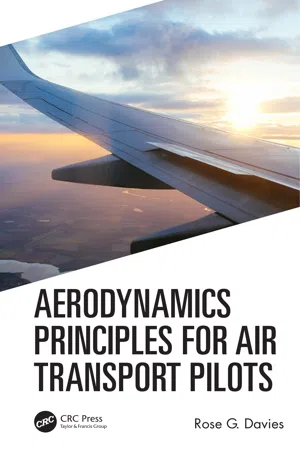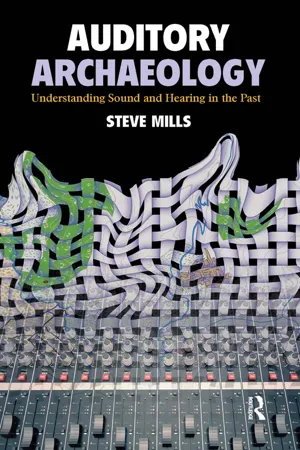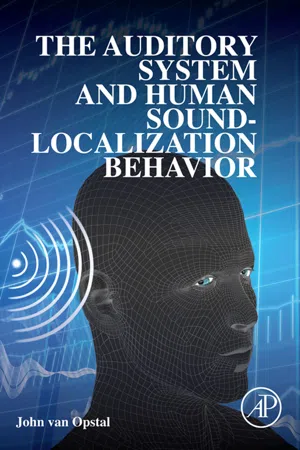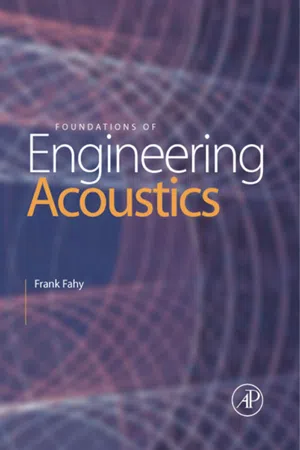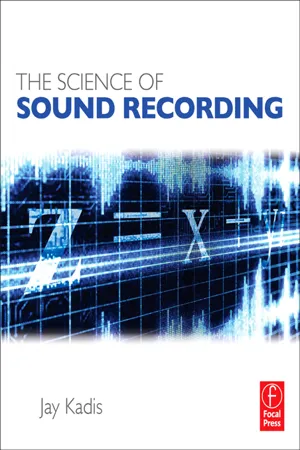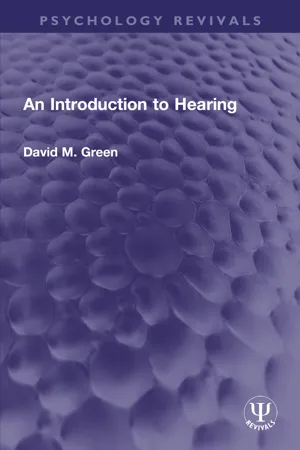Technology & Engineering
Speed of Sound
The speed of sound refers to the rate at which sound waves travel through a medium, such as air, water, or solid materials. It is influenced by the density and elasticity of the medium. In air at room temperature, the speed of sound is approximately 343 meters per second (1235 kilometers per hour).
Written by Perlego with AI-assistance
7 Key excerpts on "Speed of Sound"
- eBook - ePub
Occupational Noise and Workplace Acoustics
Advances in Measurement and Assessment Techniques
- Dariusz Pleban, Dariusz Pleban(Authors)
- 2020(Publication Date)
- CRC Press(Publisher)
T:f = 1 / T Hz(1.2) • The Speed of Sound (sound wave propagation velocity) c, or the velocity at which any disturbance of equilibrium propagates in the medium, is defined as the ratio of path traveled by the disturbance in an elementary interval of time to the interval value. The Speed of Sound can be calculated as:
the value of the Speed of Sound in air at temperature 20°C and under normal pressure is about 340 m/s.c = λ / T = λ ⋅ f m/s(1.3) • The particle velocity u is the speed at which a particle of medium moves in the course of the passage of a sound wave expressed in m/s and in general, is a vector quantity. Absolute value of the particle velocity (length of the particle velocity vector) is small and does not exceed a fraction of one meter per second.When analyzing propagation of a sound wave, it is necessary to take into consideration acoustic properties of the medium. By way of analogy to optics (where properties of electromagnetic waves are considered), in the propagation of a sound wave in an inhomogeneous medium, especially when a wave encounters a boundary between two media with different acoustic properties, such phenomena as reflection, absorption, and transmission (penetration) of sound waves occur as a result of impact with a partition (e.g., a wall of an enclosure). Properties of the medium most commonly used in acoustics include: - eBook - ePub
- Rose G Davies(Author)
- 2020(Publication Date)
- CRC Press(Publisher)
6Speed of Sound and Mach NumberSound wave is a pressure wave, which is a longitudinal wave. A pressure wave travels in a medium at the Speed of Sound. The medium can be a solid, liquid, or gas, or a multiphase mixture. Any change in properties of the medium might lead to the change of Speed of Sound. Table 6.1 , which is produced from the data in the Handbook of Physics (Benenson et al., 2002), shows the values of Speed of Sound in different media. Speed of Sound depends on the property of the material. The data displayed in Table 6.1 were obtained under specific condition of temperature. For example, the Speed of Sound in air is different when air temperature is different. The Speed of Sound in air is the focus of this chapter.TABLE 6.1Speed of Sound in various materials (20°C).Material Speed (ms−1 )Air 343 Air (0°C) 331 Carbon dioxide 258 Water 1480 Sea water 1470 Kerosene 1451 Aluminum 5200 Titanium 6070 A disturbance in air property (not heat transfer) at a location of an air system will propagate through the air at the Speed of Sound in all directions. For example, a piston presses air in a cylinder: The air pressure increases everywhere inside the cylinder when the piston is pushed. In this case, the speed of the piston’s move is much lower than the Speed of Sound, so the wave of pressure change propagates throughout the cylinder before the next move of the piston, and the increase of air pressure inside the cylinder is approximately uniform.Speed of Sound in Air
A sound wave is a pressure wave (a pressure disturbance), and a pressure wave propagates at Speed of Sound. In a gas system, the density, or temperature, or both density and temperature would change if the pressure of the system changed. To establish the function between the Speed of Sound and air property, we need to set up a flow system, which can just simply display the change of air pressure, density and temperature when the disturbance passes through the system. - eBook - ePub
Auditory Archaeology
Understanding Sound and Hearing in the Past
- Steve Mills(Author)
- 2016(Publication Date)
- Routledge(Publisher)
Sound travels through air (or any other medium) as a longitudinal wave moving away from the source as the result of particles oscillating back and forth about a fixed point. The physics of wave motion is complex and only a basic description will be provided here. The Speed of Sound in air is approximately 344 m/sec at 20°C (Harris 1979: 2.2). As the motion energy in air molecules changes with temperature (they move faster at higher temperatures) the Speed of Sound likewise changes with an increase of 0.61 m/sec for every 1°C increase in temperature. In most everyday situations the changes in the Speed of Sound as a consequence of changes in temperature have little, if any, noticeable effect for humans. The Speed of Sound is also influenced by atmospheric pressure and humidity but these rarely make any noticeable difference except in situations that diverge significantly from 1 atmosphere (Piercy and Embleton 1979: 3.10). The Speed of Sound can be altered significantly by wind velocity and direction. Sound travels faster in liquids than through air and faster still through solids.In many situations (particularly outdoors) sound waves propagate in all directions equally (isotropically) from a sound source producing concentric spherical waves of compression and rarefaction (Harris 1979: 2.2). In such situations the object producing the sound is at the centre of the propagating sound waves. There are, however, many situations in which sound waves do not propagate equally in all directions from a sound source. The propagation of sound waves from a sound source can be influenced by the shape of the sound source resulting in more sound waves propagating in certain directions than in others. In addition, the presence of obstacles such as walls can result in effects on the propagation of sound waves including echoes, reverberation, absorption, diffraction and resonance (Piercy and Embleton 1979; Waterhouse and Harris 1979; and see below).The decay (attenuation) of sound with distance from a sound source is dependent on the shape and size of the sound source and the surrounding conditions (Harris 1979: 2.7). When the sound source is small and the surrounding conditions are homogenous and free from reflecting or absorptive surfaces (free-field conditions) the decay of sound follows the inverse square law. Under such conditions with each doubling of distance from the source the sound decays by half. In enclosed spaces where there are more reflective and absorptive surfaces the decay of sound is more complex involving effects such as reverberation (Waterhouse and Harris 1979: 4.5). The attenuation of sound with distance is in part a consequence of atmospheric absorption where the sound waves are converted into heat (Piercy and Embleton 1979: 3.10). This has a negligible effect at short distances but can have a significant effect at distances of more than several hundred metres and with large changes in altitude. - John van Opstal(Author)
- 2016(Publication Date)
- Academic Press(Publisher)
Chapter 2The Nature of Sound
Abstract
This chapter summarizes the physical properties of sound waves that will be relevant in the later chapters. A simple elastic gas model can explain how the propagation Speed of Sound depends only on the bulk modulus and density of the air. We then introduce the homogeneous linear wave equation, from which the superposition of harmonic solutions (standing waves and traveling waves), and the concept of Fourier series are derived. As an example, we discuss the fundamental problem of spectral–temporal resolution. We then describe how inhomogeneities in the medium may change the wave equation and lead to nonharmonic spatial waves. We introduce the concept of acoustic impedance, and how this defines the conditions for transmission and reflection at boundaries between different media. We illustrate these ideas for the middle-ear transfer of acoustic energy from air to the fluid-filled cochlea. Finally, we discuss how the dispersion relation for homogeneous and inhomogeneous media relates to the phase and group velocities of the acoustic signals.Keywords
Speed of Sound acoustic impedance wave equation superposition Fourier series binaural beats transmission reflection decibel dispersion relation phase velocity group velocity2.1. Longitudinal pressure waves in a medium
Sound is a pressure perturbation in a medium like air or water, which is caused by a vibratory source that oscillates in the 50–20,000 Hz range (Serway and Jewett, 2013 ). The perturbation propagates as a longitudinal traveling wave through the medium, in which the molecular movements associated with the perturbation are along the same direction as the propagating traveling wave. Think of a vibrating membrane (a loudspeaker) at position x = 0, moving inward and outward in the x -direction at frequency f 0 Hz. When the membrane moves, it pushes or drags the air molecules at x = 0 in the same direction, thereby creating a local increase or decrease in the density of air molecules, which consequently increases or decreases the local pressure. These pressure changes propagate in the x -direction through the medium. The wave is thus described by a succession of compressions (regions of high pressure, c ) and rarefactions (regions of low pressure, r ), which propagate through the medium at velocity v sound . In air, at sea level at a temperature of 20°C, and at a mean pressure of 105 N/m2 (1 atm), the Speed of Sound is approximately v sound- eBook - ePub
- Frank J. Fahy(Author)
- 2000(Publication Date)
- Academic Press(Publisher)
−1 ).Acoustic disturbances propagate in the form of waves. A wave in a material medium may be defined as a process by means of which a disturbance from equilibrium is transported through the medium without net transport of mass. For example, observation of lightweight flotsam disturbed by straight-crested waves in deep water reveals that the surface water particles move principally in circular orbits in the vertical plane in a process governed by the interaction of gravity-induced hydrostatic pressure and fluid inertia: the particles don’t seem to ‘go anywhere’. (Closer observation will reveal a slow net transport of the floating objects, but this is a secondary effect, and they clearly do not move at the speed of the wave.) Waves also transport energy and momentum associated with the disturbances.If one could observe the motion of the fluid particle in a sound wave generated by a sound source operating in a largely non-reflecting environment, such as the air above a hay field, one would see it moving to and fro along the direction of propagation. Consequently, sound waves in fluids are longitudinal waves, unlike the aforementioned water waves. However, where sound waves arrive simultaneously from many directions, the particles describe much more complicated motions. This is not because the sound waves interact to affect each other: at the levels of sound experienced in everyday life, sound waves arriving from different directions pass through each other unchanged. This is fortunate; consider what would otherwise happen in the concert hall or in the lecture theatre. Such behaviour is said to satisfy the principle of linear superposition. However, very intense sound, such as that in the exhaust pipes of internal combustion engines, near the exhausts of turbo-jet aero engines or close to explosive events, does not satisfy this principle, with the consequence that the form of the disturbance varies as it propagates. - eBook - ePub
- Jay Kadis(Author)
- 2012(Publication Date)
- Routledge(Publisher)
CHAPTER THREE Sound Contents The Physics of Sound The Physics of Gases Sound Propagation Sound Refraction and Diffraction Acoustics Room Modes of Reflection Suggested ReadingAcoustics, the study of sound, is a topic that can quickly mystify the casual observer. Fundamentally, it is the physics of how air molecules as a population behave when excited by moving objects. The mathematics used to describe this behavior can be complicated, especially as mathematics isn’t our native language. Nonetheless, the behavior itself is conceptually simple enough – as anyone who has tossed pebbles into a pond knows. A rock striking the water’s surface causes ripples to spread out in all directions until they bounce off the edges of the pond and reflect back at the same angle from which they arrived, adding and subtracting with each other to produce a complicated pattern on the water’s surface. Sound waves behave similarly but with one significant difference: air is far more compressible than water. The springiness of the air allows sound waves to propagate as pressure variations in three dimensions, whereas the water’s surface must be deformed to allow the wave to pass. Sound waves are longitudinal waves – that is, the waves of compression and rarefaction move in the direction of wave travel – and water waves, like vibrating strings, are transverse waves in which the movement is perpendicular to the direction of propagation.THE PHYSICS OF SOUNDSound propagation depends on the exchange of energy between air molecules. Any gas above absolute zero temperature is in constant motion, with the molecules careening off of each other in a series of random collisions whose total energy is determined by the heat content, which we measure as the temperature of the gas. The higher the temperature, the more agitated the molecules become. Sound energy originates when a vibrating object in contact with the gaseous medium (usually air) forces the air molecules to move with the moving surface. The movement imparts a net velocity to the ricocheting molecules and they bunch up as the moving surface pushes them together in an outward direction. When the molecules move closer together, the air pressure – the cumulative force the molecules exert on each other and any object they encounter – increases. Thus there are two forms of energy contributing to sound propagation: the net velocity of the molecules (kinetic energy) and the pressure they exert (potential energy). Energy can be exchanged back and forth between the two forms, but – as we know from classical physics – it can be neither created nor destroyed. It can be dissipated, though, by expending energy as heat or by doing work, where force is exerted over a distance to move a mass. The total sound intensity at a distance from a sound source is the product of the two forms of energy measured at that point: - eBook - ePub
- David M. Green(Author)
- 2021(Publication Date)
- Routledge(Publisher)
However, we want to understand the relation between what we hear and the physical aspects of sound. We therefore begin with a consideration of sound as a physical entity. From a physical viewpoint, sound is a mechanical disturbance that is propagated through an elastic medium. This physical disturbance alters certain properties of the medium, and the rapid variation of one of them, for example, the variation of pressure as a function of time, might be called the sound wave. We are primarily interested in this mechanical disturbance as it moves in air, but sound can also move in liquid or solid structures as well. Air is composed of a mixture of molecules, the majority being oxygen, nitrogen, and hydrogen. The molecules of a gas move about freely in space, colliding with other molecules or any surface containing the gas. The mass of the molecules and the velocity of their motion determine the temperature of the gas. These factors, along with the number of molecules per unit volume, also determine how far, on the average, molecules travel before colliding with other molecules. The gas molecules wander about at random in an undisturbed state. As a result of their collisions with other objects, they create a net static pressure on an object placed in the gas. Pressure is defined as a force per unit area, and static pressure is essentially the pressure measured by a barometer. The “barometric” pressure represents the force produced by the impact of the moving gas molecules, averaged over both time and space. The magnitude of the static pressure is determined by the speed of the molecules, their mass, and the density of the gas, that is, the number of molecules per unit volume. Air at sea level contains about 2.7 × 10 19 molecules per cubic centimeter and is a mixture of different molecules the velocities of which depend on their mass
Index pages curate the most relevant extracts from our library of academic textbooks. They’ve been created using an in-house natural language model (NLM), each adding context and meaning to key research topics.
Explore more topic indexes
Explore more topic indexes
1 of 6
Explore more topic indexes
1 of 4

